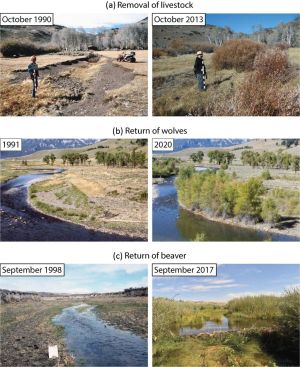Bring Back the Beaver
Ecosystem Restoration
Beavers build dams across waterways creating ponds behind them. These Beaver ponds create important habitat for many other species, including juvenile Coho salmon. Some migratory birds also prefer beaver ponds to more open bodies of water. Streams and rivers where beaver dams are present have higher clarity levels and lower pollution levels by slowing and sinking particles.[1]
Wolves and Beavers
In a paper published today in BioScience, “Rewilding the American West,” authors from CU Boulder, Oregon State University and several other institutions suggest using nearly 193,000 square miles (500,000 square kilometers) of federal lands in 11 states to establish a contiguous network based on potential habitat for the gray wolf and American beaver. Supporting those species through management changes on federal land would help control elk populations, support tree growth, boost biodiversity, improve water quality, increase carbon sequestration and restore riparian habitats, they said.[2]
Disaster Resilience
Beavers help watersheds become more resilient and resistant to wildfire damage. Scientific research has demonstrated that streams without beavers burn three times more intensely than the streams with beavers. According to Dr. Emily Fairfax:
"By building its dam and then expanding that dam, and then digging these little canals out into the landscape, beavers are creating these really broad swathes of landscape that can resist all sorts of disturbances."[3]
Historical Rectification
Beaver populations across Turtle Island are currently an estimated 5-10% of their recent size (pre 1800s) of 100-200 million as a consequence of their mass slaughter for capitalist profits under European colonialism. The movement to bring back the beaver aims to help end and reverse this ecocide through restoring beaver populations closer to their previous size.[4]
See also:
Sources
To Add
https://climatewaterproject.substack.com/p/beavers-biology-and-slow-water-brock https://oaec.org/projects/bring-back-the-beaver-campaign/ https://catchmentbasedapproach.org/learn/managing-wetlands-using-beavers/
In Cascadia:
Salt Spring Island: https://watershedsentinel.ca/articles/beavers-restoring-wetlands/ Bismark Meadows: https://www.vitalground.org/restoring-wetlands-beavers-bismark-meadows
